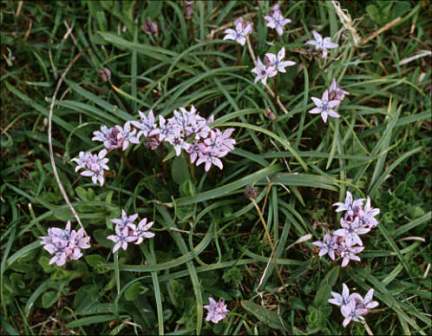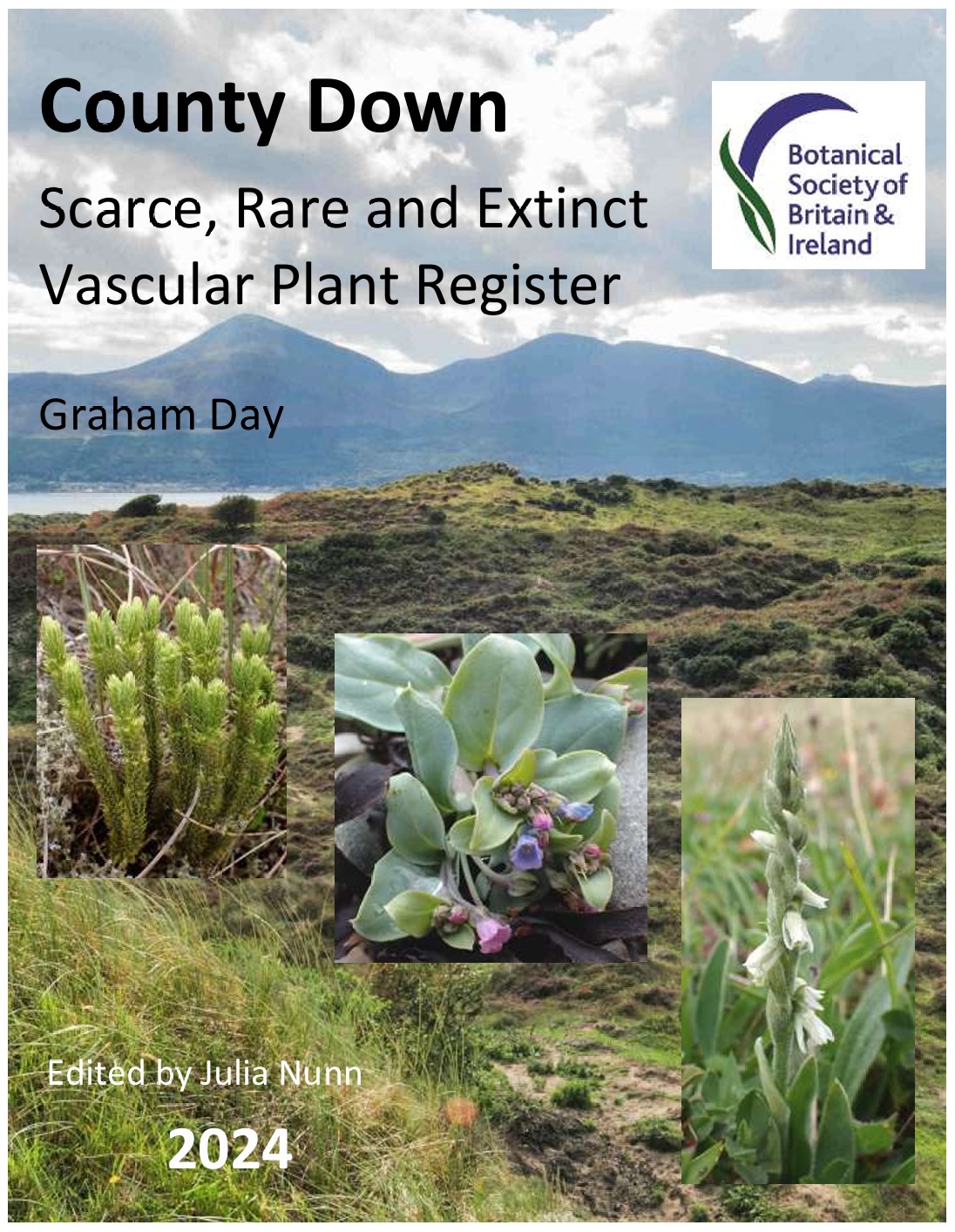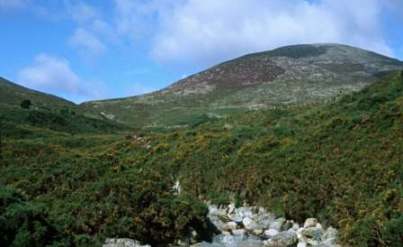
Botanical Recording in Co. Down in 2024
Almost 6200 plant records from County Down were added to the BSBI database in 2024. Many thanks to those who contributed, including Suzanne Belshaw, Lesley Crawshaw, Cathryn Cochrane, Jake Dalzell, Jen Farrar, Margaret Marshall, Valerie Macartney, Peter McEvoy, Ian McNeill, David McNeill, Julia Nunn, Matthew Porter, Rhonda Ridley, Paul Stanley, Tim Rich, Dean Mac Cu Uladh and John Wann.
During the New Year Plant Hunt Erinus alpinus (Fairy Flax) was recorded flowering in Downpatrick and Zantedeschia aethiopica (Altar-lily) was flowering in Portavogie. Erigeron bonariensis (Argentine Fleabane), first vc record, was found in Portaferry.
In January Viscum album (Mistletoe) was recorded at Banbridge and Holywood by P. McEvoy and John Wann respectively.
In April, Geranium reuteri (Canary Herb-Robert), first vc record, was found as a garden escape by Ringhaddy.
In late-April I found Diplotaxis erucoides (White Rocket) by the Connswater Greenway during the Belfast bioblitz, the first record for Ireland. Other finds included Claytonia perfoliata (Springbeauty) at CS Lewis Square and Helminthotheca echioides (Bristly Oxtongue) at Victoria Park.
In early May, most of the Rosemount estate, Greyabbey was opened for a weekend to the public. Much of the managed woodland was dominated by Hedera helix (Common Ivy) but a moderately diverse range of woodland plants were found to be persisting. Catabrosa aquatica (Whorl-grass) was noted at a muddy puddle by an access track and Myosotis discolor (Changing Forget-me-not) was abundant on a concrete pad used for storing silage bales.
The Ballyedmond estate near Killowen was visited with the Irish Garden Plant Society in early May. This was closely managed by a team of permanent gardeners, but some useful records were made and a return visit could be rewarding. Actaea simplex (A Baneberry) was self-sown in paving cracks, a first record. Cardamine occulta (A Bitter-cress), Oxalis exilis (Least Yellow-sorrel), Tellima grandiflora (Fringecups) were also noted. While in the area, records were also made around Killowen village. Sasa veitchii (Veitch's Bamboo), a first vc record, and garden escape, was noted.
I led a botanical meeting for the Belfast Naturalists Field Club at Rostrevor Oak Wood NNR in mid-May. Unfortunately, the bluebells were well past their best as a consequence of a dry, warm spring, but over 160 records were made from the monad including Dryopteris cambrensis (Narrow Male-fern).
Neottia nidus-avis (Bird’s-nest Orchid) was re-found at Tollymore Forest Park by C. Cochrane in late May.
Minnowburn Beeches by the River Lagan in Belfast were visited in late May with the intention of seeing Cardamine amara (Large Bitter-cress) in full flower and obtaining grid references for this. Records were also made of Heracleum mantegazzianum (Giant Hogweed), Papaver cambrica (Welsh Poppy) and Moehringia trinerva (Three-nerved Sandwort).
I attended a meeting of the British Pteridological Society at Crawfordsburn Country Park and cooperated in the identification of a range of ferns.
A green road at Clough was investigated in early June and a range of rose species and hybrids were seen. Samples were sent to the referee, Roger Maskew, in late August and among these was Rosa vosagica x sherardii, the first Irish record.
While recording at Annacloy, a prolific blue creeper was found. This was identified as Isotoma fluviatis (Blue Star Creeper), described by the RHS as ‘A low-growing, creeping perennial forming a dense, leafy mat’, and may be the first UK record.
In mid-June I walked over Pigeon Rock in the Mourne Mountains to follow up a record of Cryptogramma crispa (Parsley Fern) from D. Cassidy on iRecord in 2023. It was previously last seen in 2002 in the Mournes and on this occasion I noted several plants at two stations on Pigeon Rock.
Drumaroad held two surprises in early July; Allium schoenoprasum (Chives) and Glebionis coronaria (Crown Daisy), both roadside introductions and first vc records.
Also in early July, the Lagan Canal at Annaghdroghal was found to be heavily overgrown and access to Lough Neagh blocked by a double barbed wire fence. However, the tow-path was open to the east of Annaghdroghal Bridge and with care, samples of Carex riparia (Greater Pond-sedge) and Carex pseudocyperus (Cyperus Sedge) were collected. Bromopsis ramosa (Hairy-brome) was re-found at the end of Annaghdrogal Lane and I was pleased to note Agrimonia eupatoria (Agrimony) was still present on the bridge despite re-surfacing of the road.
D. Cassidy made records of Phegopteris connectilis (Beech Fern), Rhodiola rosea (Roseroot) (first record at this location) and Selaginella selaginoides (Lesser Clubmoss) from Slievemoughanmore on iRecord in mid-July.
Mertensia maritima (Oysterplant) and Glaucium flavum (Yellow Horned-poppy) were not re-found along the Bloody Bridge coastal path in mid-July. Previously they were found among shingle at the top of the beach and it is likely movement of beach material during storms had rendered them extinct.
In early August Jake Dalzell and I led field meetings to Legnaboe on the Lecale coast and Killard NNR. A report will appear in the BSBI Yearbook.
In early August S. Thompson of the Ulster Wildlife Trust recorded Erigeron acris (Blue Fleabane) at several stations at Ballykinler. It was last recorded here in 1936. S. Belshaw recorded Linum radiola (Allseed) (only the third recent record) at Donagadee. Both records were made on iRecord.
In late August targeted searches re-found Carduus tenuiflorus (Slender Thistle), Parapholis strigosa (Hard-grass) and Torilis nodosa (Knotted Hedge-parsley) on the Outer Ards Peninsula with R. Ridley (Ulster Museum), M. Flood (DAERA) and R. McCready (DAERA).
P.D. Stanley sent records from several sites in Co. Down following a visit in August. Several were new vc records and included Atriplex praecox (Early Orache) at Killard, Physalis peruviana (Cape-gooseberry) at Newcastle and Spergularia bocconei (Greek Sea-spurrey) near Lisburn.
In August and September D. McNeill made some highly significant records in the Mourne Mountains. In early August he recorded Carex pauciflora (Few-flowered Sedge) on Castle Bog and by the Rocky Water stream, probably the only locations in Co. Down. Various stations had been recorded by John Harron for this taxon in the area, but it had last been seen in 2011. In late August David recorded Hymenophyllum wilsonii (Wilson's Filmy-fern) and Phegopteris connectilis (Beech Fern) at the Great Gully by Shanlieve mountain. In early September he re-found Cryptogramma crispa (Parsley Fern), Cystopteris fragilis (Brittle Bladder-fern), Phegopteris connectilis (Beech Fern), Rhodiola rosea (Roseroot) and Salix herbacea (Dwarf Willow) on Slieve Muck.
Sorbus hibernica (Irish Whitebeam) was re-found near Dundrum by the line of the old railway by Frazer Mack who posted the record on iRecord in mid-September. This was last seen here in 2012.
Sanguisorba officinalis (Great Burnet) was re-found in Donaghadee close to the line of the old railway by Gavin Marshall who posted the record on iRecord in late September. This is close to the previously known location for this protected species, which was last seen here in 2004.
A query by Sylvia Reynolds led me to search for local Fleabanes in October. I was able to find Erigeron floribundus (Bilbao Fleabane) in Newtownards and Portaferry, Erigeron sumatrensis (Guernsey Fleabane) (first vc record) at two locations in Portaferry and Erigeron bonariensis (Argentine Fleabane) in Newtownards (second vc record). Samples of all species were given to the Ulster Museum.
Graham Day
3/1/25
County Recorder
Ulster Botany group on Facebook
You might also like to join the Ulster BSBI Botany Facebook Group - a place to share botanical knowledge, events and pictures.
Recording Card
If you would like to record in the county, then you may download the County Down recording card here. Species lists should normally be within 1 km squares where possible (4 figure grid reference), with rare plants preferably recorded to 10 m (8 figure grid reference). Any notes on rare species found would be appreciated.

Co. Down Botanical Sites
County Down has many places that are worth visiting to record plants and the Site List (available to download as a spreadsheet ) is intended to encourage recording within the county. The list is not exhaustive and there will be places that are well worth adding. If you know of somewhere that I have overlooked, please let me know.
Note that Northern Ireland does not have many public rights of way and access may need permission from the landowner.
Rare Plant Register

The Flora of County Down
This is a new project, beginning in 2010, for 10 seasons, to record the flora of County Down for a proposed publication. A new date class will be used, Date Class 5 (2010-2019), as initiated by the BSBI. This would essentially require that there be new complete coverage of the county. Species will be recorded to 1 km or better, with mapping to 2 km squares.
The current status of records held on the database Recorder for County Down is:
Total vascular plant records for County Down: 237, 487
- Date class 1: pre-1970: 6,411
- Date class 2: 1970-1986: 17,520
- Date class 3: 1987-1999: 105,397
- Date class 4: 2000-2009: 71,754
- Date class 5: 2010-2019: 36,405
No. of taxa: 1,872 [all status]

Guidance for participants at field meetings is available here.